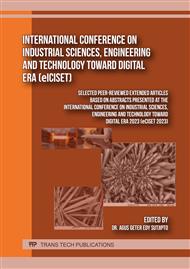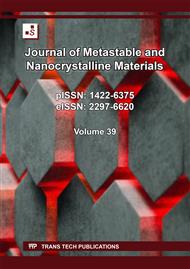[1]
J. Bohm (1987) The History of Crystal Growth, AACG Newsletter, Vol. 17(2)
Google Scholar
[2]
J. Chennupati and S.J. Pearton (2006) Zinc oxide bulk, thin films and nanostructures: processing, properties and applications. New York: Elsevier.
Google Scholar
[3]
M. Cooke (2007) Compounds and Advanced Silicon, Semiconductor Today, Vol.2 Issue 4
Google Scholar
[4]
M. Hadis and O. Ümit(2009) Zinc Oxide: Fundamentals, Materials and Device Technology. Virginia: Wiley
Google Scholar
[5]
Klaus, E., Andreas, K., and Bernd, R. (2008) Transparent Conductive Zinc Oxide: Basics and Applications in Thin Film Solar Cells. Japan: Springer Japan KK
Google Scholar
[6]
Takahiko Sakaue and Katsuhiko Yoshimaru (2005) Study of Fine Copper Powder for Electrodes of Chip Device, Taipei
Google Scholar
[7]
Zhong Lin Wang (2004) Zinc oxide nanostructures: growth, properties and Applications. School of Materials Science and Engineering, Georgia Institute of Technology, Atlanta, Matter 16
Google Scholar
[8]
A.G.E. Sutjipto, Y.P. Asmara, M.A. Jusoh: Behavior of MgO Based Ceramics under Electron Irradiation. Procedia Engineering (Elsevier), Vol. 170, pp.88-92, 2017.
DOI: 10.1016/j.proeng.2017.03.017
Google Scholar
[9]
A.G.E. Sutjipto, M. Takata: The use of SEM to investigate the effect of an electron beam on the optically-visible flashover treeing of MgO ceramic. Journal of Materials Science, Springer, 42, pp.6036-6040, 2007.
DOI: 10.1007/s10853-006-1094-4
Google Scholar
[10]
Razi, F. Azreen, A.G.E. Sutjipto, A.S. Mohamad: Development of Cu-SiC composite for electrical discharge machining electrode using powder metallurgy technique. Advanced Materials Research, 576. pp.203-207, 2012.
DOI: 10.4028/www.scientific.net/amr.576.203
Google Scholar
[11]
A.G.E. Sutjipto, T. Okamoto, M. Takata: Appearance of Flashover Treeing on Polycrystal-line Magnesia Surface. Key Engineering Materials, 181-182, p.231, 2000.
DOI: 10.4028/www.scientific.net/kem.181-182.231
Google Scholar
[12]
A.R.F. Azreen, A.G.E. Sutjipto, E. Y. T. Adesta: Fabrication of CuSiC Composite by Powder Metallurgy Route. Advanced Materials Research, 264-265, pp.748-753, 2011.
DOI: 10.4028/www.scientific.net/amr.264-265.748
Google Scholar
[13]
A.G.E. Sutjipto: The Effect of CaO Addition on the Microstructural. Mechanical and Dielectric Properties of Pure MgO Ceramic, Key Engineering Materials, 345-346, p.1609, 2007.
DOI: 10.4028/www.scientific.net/kem.345-346.1609
Google Scholar
[14]
A.G.E. Sutjipto, T. Okamoto, M. Takata, Flashover Treeing of Magnesia Surface under Electron Beam Bombardment in Vacuum. Transaction of the Materials Research Society of Japan, 25(1), p.512, 2000.
DOI: 10.4028/www.scientific.net/kem.181-182.231
Google Scholar
[15]
Jufriadi, A.G.E. Sutjipto, R. Othman, R. Muhida: Discharge, microstructural and mechanical properties of ZrO2 addition on MgO for plasma display panel materials. Materials Research Innovations 13 (3), pp.149-152, 2009.
DOI: 10.1179/143307509x437473
Google Scholar
[16]
A.G.E. Sutjipto, R. Muhida, M.Takata: An SEM Flashover: Technique to Characterize Wide Band Gap Insulators. Proceeding of International Conference on Property and Dielectric Materials 2006, Denpasar, Bali, pp.216-219, 2006. ISBN: 1-4244-0189-5. IEEE Publisher.
DOI: 10.1109/icpadm.2006.284156
Google Scholar
[17]
D. Nezaki, M. Yasuda, T. Yasui, and M. Takata, "Selective area growth of ZnO crystals by electric current heating,"Solid State Ionics, vol. 172, no. 1-4 SPEC. ISS., p.353–355, 2004.
DOI: 10.1016/j.ssi.2004.02.069
Google Scholar



